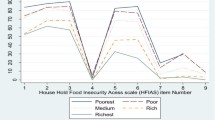Abstract
The State of Paraiba in Northeastern Brazil ranks as the fourth poorest state in the country. The objectives of this study are to conduct the psychometric validation of the Brazilian Household Food Insecurity Scale (EBIA), to assess the household food insecurity (HFI) prevalence, and to identify the association between HFI, poverty and dietary intake in a representative sample of Paraiba’s 14 poorest municipalities (N = 4533). All municipalities included had fewer than 50,000 inhabitants. EBIA had strong internal consistency (Cronbach’s alpha = 0.93 and 0.90 in households with and without children, respectively). The percentage of affirmative responses for each item was inversely associated with household income and the item curves were parallel across socio-economic strata. Rasch modeling indicated that: a) scale items severities followed theoretical expectations, b) all items had an adequate fit to the scale confirming its unidimensionality, and c) items ‘functioned’ similarly across key subpopulation characteristics including: urban/rural; men/women; younger/older; poor/less poor; Bolsa Familia enrollment (yes/no). HFI prevalence was higher in rural than in urban areas (55.5 % vs. 49.9 %, p < 0.0005) and severe food insecurity was substantially higher in rural areas (14.0 % vs. 9.0 %, p < 0.0005). HFI severity was inversely associated with household income, positively associated with daily sugar consumption and inversely associated with daily consumption of bread and nutrient dense foods (fruits, vegetables, and dairy). In conclusion, EBIA had strong internal and external validity at the municipal level. Findings are particularly relevant for Brazil where 89.1 % of municipalities (4,957 out of 5,565 municipalities) have less than 50,000 inhabitants.







Similar content being viewed by others
References
Bond, T. G., & Fox, C. M. (2001). Applying the Rasch Model: Fundamental measurement in the human sciences. New Jersey: Lawrence Erlbaum Associates Inc. Publishers.
Derrickson, J. P., Fisher, A. G., & Anderson, J. E. (2000). The core food security module scale measure is valid and reliable when used with Asians and Pacific Islanders. The Journal of Nutrition, 130(11), 2666–2674.
Gubert, M. B., Benício, M. H., & Santos, L. M. (2010). Estimates of severe food insecurity in Brazilian municipalities. Cadernos de Saúde Pública, 26(8), 1595–1605.
Hackett, M., Melgar-Quinonez, H., Perez-Escamilla, R., & Segall-Correa, A. M. (2008). Gender of respondent does not affect the psychometric properties of the Brazilian household food security scale. International Journal of Epidemiology, 37(4), 766–774.
Hromi-Fiedler, A., Bermudez-Millan, A., Segura-Perez, S., Damio, G., & Perez-Escamilla, R. (2009). Adaptation of the U.S. food security survey module for low-income pregnant Latinas: qualitative phase. Journal of Hunger & Environmental Nutrition, 4(1), 62–80.
IBGE (2006). Pesquisa Nacional de Amostra por Domicilios—Suplemento Segurança Alimentar, 2004. Rio de Janeiro. Instituto Brasileiro de Geografia e Estatística, Coordenação de Trabalho e Rendimento.
IBGE (2007). Contagem populacional. Instituto Brasileiro de Geografia e Estatística. http://www.ibge.gov.br/home/estatistica/populacao/contagem2007/default.shtm Accessed June 5, 2011.
IBGE (2008). Síntese de Indicadores Sociais: Uma Análise das Condições de Vida da População Brasileira. Rio de Janeiro. Instituto Brasileiro de Geografia e Estatística. Informação Demográfica e Socioeconômica, n 23.
Kac, G., Velásquez-Melendez, G., Schlüssel, M. M., Segall-Côrrea, A. M., Silva, A. A., Pérez-Escamilla, R. (2012) Severe food insecurity is associated with obesity among Brazilian adolescent females. Public Health Nutr. Jan 17:1–7 (epub ahead of print).
Melgar-Quinonez, H., Nord, M., Perez-Escamilla, R., & Segall-Correa, A. M. (2008). Psychometric properties of a modified U.S. household food security survey module in campinas, Brazil. European Journal of Clinical Nutrition, 62(5), 665–673.
Panigassi, G., Segall-Corrêa, A. M., Marin-León, L., Pérez-Escamilla, R., Sampaio, M. F. A., & Maranha, L. K. (2008). Insegurança alimentar como indicador de iniqüidade: análise de inquérito populacional. Cadernos de Saúde Pública, 24(10), 2376–2384.
Pérez-Escamilla, R., & Segall-Corrêa, A. M. (2008). Food insecurity measurement and indicators. Revista de Nutrição. Campinas: Pontifícia Universidade Católica de Campinas—PUC-Campinas, 21(suppl), 15S–26S.
Pérez-Escamilla, R., Segall-Corrêa, A. M., Kurdian, M. L., Sampaio, M. M. F., Marín-León, L., & Panigassi, G. (2004). An adapted version of the U.S. department of agriculture food insecurity module is a valid tool for assessing household food insecurity in Campinas, Brazil. The Journal of Nutrition, 134(8), 1923–1928.
Santos, J. V., Gigante, D. P., & Domingues, M. R. (2010). Prevalence of food insecurity in Pelotas, Rio Grande do Sul State, Brazil, and associated nutritional status. Cadernos de Saúde Pública, 26(1), 41–49.
Segall-Corrêa, A. M., Pérez-Escamilla, R., Sampaio, M. F. A., Marin-León, L., Panigassi, G., Maranha, L. K., et al. (2004). Acompanhamento e avaliação da segurança alimentar de famílias brasileiras: validação de metodologia e de instrumento de coleta de informação: urbano/rural. Campinas: Universidade Estadual de Campinas. http://www.opas.org.br/publicmo.cfm?codigo=76 Accessed June 5, 2011.
Smith, E. V., Conrad, K. M., Chang, K., & Piazza, J. (2002). An introduction to Rasch measurement for scale development and person assessment. Journal of Nursing Measurement, 10(3), 189–206.
UNPD (2003). Brazilian human development Atlas. United Nations Development Programme. Brasília. http://www.pnud.org.br/atlas/tabelas/index.php Accessed June 5, 2011.
Wilde, P. E. (2004). Differential response patterns affect food-security prevalence estimates for households with and without children. Journal of Nutrition, 134(8), 1910–1915.
Acknowledgments
We are grateful to the Brazilian Research and Science Council (CNPq) for supporting this study through grant no. 503359/2003-3 and 201796/2010-4. Presented at the International Scientific Symposium on Food & Nutrition Security Information: From valid measurement to effective decision-making. UN Food and Agricultural Organization (FAO) Headquarters, Rome, 17–19 January 2012.
Conflict of interest
The authors have no conflict of interest to declare.
Author information
Authors and Affiliations
Corresponding author
Rights and permissions
About this article
Cite this article
de Toledo Vianna, R.P., Hromi-Fiedler, A.J., Segall-Correa, A.M. et al. Household food insecurity in small municipalities in Northeastern Brazil: a validation study. Food Sec. 4, 295–303 (2012). https://doi.org/10.1007/s12571-012-0181-4
Received:
Accepted:
Published:
Issue Date:
DOI: https://doi.org/10.1007/s12571-012-0181-4




